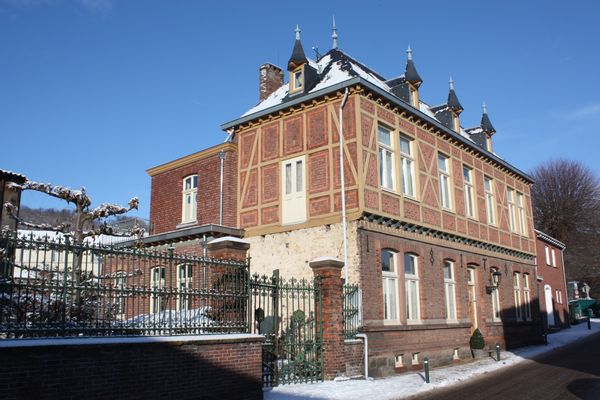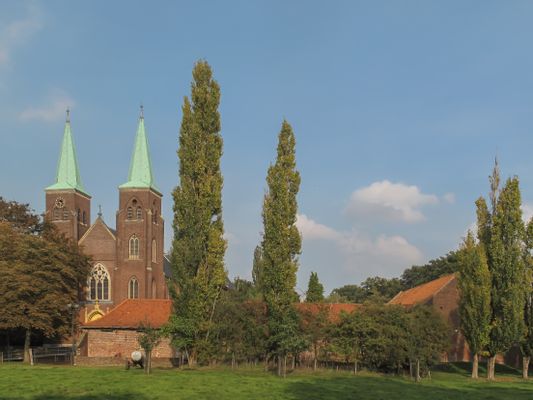Located at the Dutch-German-Belgian border, this small town is home to the Drielandenpunt - the three-country point and the highest spot in mainland Netherlands at 322.5m.
Vaals sits where the Netherlands, Germany, and Belgium meet. Stand on the tripoint marker to have one foot in each country. Walk up the Vaalserberg hill, the highest natural point in mainland Netherlands at 322 meters, or explore a large hedge maze nearby. The town’s streets mix Dutch bakeries with German-style timbered buildings and Belgian cafes. Visit the 18th-century De Kopermolen, a former church turned cultural venue, or take a 15-minute bus ride to Aachen for city museums and shopping. Green hills dotted with farms surround Vaals, with villages like Vijlen and Lemiers linked by trails for walking or biking.
Drielandenpunt: Where Three Countries Meet
The Drielandenpunt is a concrete marker where the borders of the Netherlands, Belgium, and Germany intersect. Walk around it to cross into each country within a few steps. The site sits on the Vaalserberg hill, which you can reach by a 30-minute hike from Vaals through oak and pine forests. Climb the Wilhelmina Tower on the Dutch side for views stretching to Aachen’s cathedral and the Ardennes hills. Belgium’s Boudewijn Tower, a steel observation deck built in 1994, gives a clearer vantage point over the patchwork of fields and villages below. Visit on weekdays to avoid crowds drawn by the novelty of standing in three nations at once.
The Vaalserberg Maze and Adventure Park
Next to the Drielandenpunt, a maze made of 16,000 beech hedges covers an area larger than four soccer fields. Designed in 1992, its paths twist for over 5 kilometers, with wooden bridges and puzzles to solve along the way. Reach the central platform to see above the hedges and plan your exit. The maze opens daily from 10 AM to 6 PM between April and October, with tickets costing €7 for visitors over 12. Nearby, a ropes course with zip lines and climbing walls keeps children occupied for hours.
Factories, Churches, and Vaals’ Past
Vaals grew wealthy in the 1700s from textile production. The Von Clermont House, a former dye factory, now displays old looms and explains how the industry shaped the town. Its courtyard has a fountain shaped like a dye vat and a stone memorial to WWII resistance fighters. The octagonal De Kopermolen building, originally a Lutheran church, hosts piano recitals and painting exhibitions. Look for the 19th-century Saint Paul’s Church with its 60-meter spire, visible from most parts of town, and the simpler Protestant Church with a clock tower dating to 1671.
Exploring Villages Near Vaals
Vijlen, a 10-minute drive from Vaals, holds the title of the Netherlands’ highest village at 200 meters above sea level. Walk the Vijlenerbos trail through beech forests to see grazing sheep and old stone farmhouses. In Lemiers, visit the 12th-century Saint Catharina Church with its rounded arches and faded frescoes, then explore the grassy mound marking a medieval castle’s ruins. Holset, a tiny village with two cafes, connects to trails used by local horseback riders. Rent a bike in Vaals to follow the 45-kilometer Grensroute, a cycling path that loops through Germany and Belgium.
Getting Around and Where to Eat
Vaals has no train station, but buses run every 30 minutes to Maastricht (40 minutes) and Aachen (15 minutes). Drive to the Drielandenpunt early to secure parking, or leave your car near the town center and walk uphill via the signposted footpath. Most restaurants cluster along Maastrichterlaan street—try Cafetaria Delnoye for thick-cut fries with curry ketchup or Café In den Kleinen Hap for schnitzel. Stay at Hotel-Restaurant Vaalsbergh for easy access to trails, or book a room at Kasteel Bloemendal, a 13th-century castle turned hotel. Bring comfortable shoes for uneven cobblestones and forest paths.



















